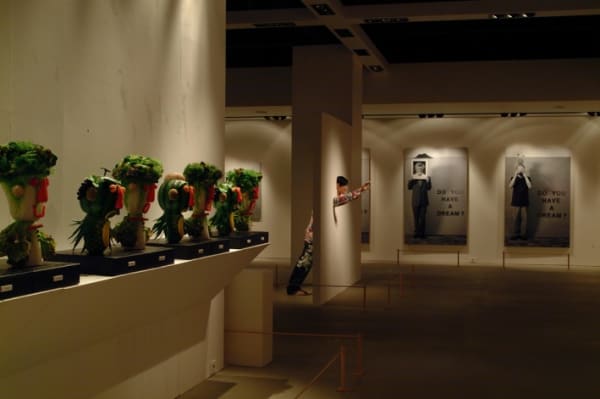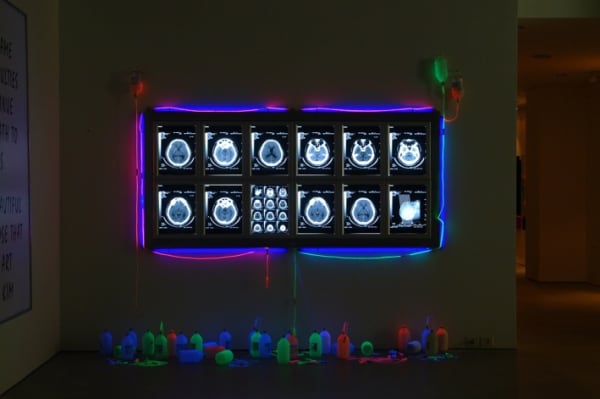CI KIM: Contemporary Art Continues
Period | 30 July – 12 October , 2003
Venue | Arario Gallery Cheonan
Works | 42 pieces including installation, sculpture and painting
Opening Reception | 6pm, 30 July , 2012
Some of CI KIM's works break the boundary between life and art, and at the same time have a popular tendency through which he asks the question about what art means in the contemporary world. In his landscape series, he allows us to overcome the busy space of reality and reminds us of the forgotten dreams and windows. In some, the struggle to find his identity shows through, as well as an attempt to overcome the socially endowed identity. What next? Looking forward to the various themes that this artist who knows no limitations and boundaries would bring, in this solo exhibition “CI KIM: Contemporary Art Continues”, Arario Gallery exhibits the overview of his art world which cannot be easily fitted into one category.
As Marshall McLuhan once said, "Our times search for the problem with the various ways instead of the only way." Today’s artists work without being restricted to certain forms or mediums. This tendency can be called the phenomenon of post-genre or the extension of genre, which theorists call post-modernism. We can clearly see this tendency in the ways that contemporary art after 1970’s unfolds.
When we consider this kind of post-genrification as a characteristic of post-modernism, we can see that CI KIM is a postmodern artist whose works are not restricted to given forms and mediums. His works include painting, object, photography, installation and video work. They also vary from a landscape paintings, filled with acrylic paints to photographic and video self-portraits, to the set of mannequins moved into an exhibition space. If someone tries to classify the artist CI KIM by examining the formal characteristics of his work, his/her desire of classification will collapse in front of the diverse forms and the mediums used in his work.
However, it’s not just through the diverse forms of his works that he is called a post-modern artist. As if largely the result of CI KIM's various identities such as businessman, art collector and artist, his work also shows diversity in the thematic side. Firstly, many of his works take the motif of mountain, sea, and forest images, KIM talks about the beauty of nature and the comfort that it gives us. He states, “When I’m going through a difficult and painful time, and when I’m in despair as I live, I seek healing in the mountains and the sea. When I fear about death as I do my business, I imagined the mountains and the seas and I enter into the beautiful world of dream”. Through this kind of comment, we can see how much comfort and courage nature has given him in his twenty-five years at the forefront of a harsh and competitive business world.
In his works, where he uses ready-made objects, CI KIM focuses on the beauty of mass-produced products and talks about the realistic dreams and desires that people have, which are in turn projected onto these objects. Designer label boxes of Armani or Ferragamo are in scripted with the text, “Do You Have a Dream?” this symbolizes people’s desires towards worldly wealth. However, CI KIM doesn’t offer any criticism towards this kind of desire for ownership or the desire to consume. Rather, he candidly states the realistic dream, such as wealth and a better lifestyle. The “dream” which is the most important theme in KIM’s art world could be something that he would want in everyday life, such as; wearing expensive designer label clothes, or living in a better house and eating more exotic food.
His work reflects on our contemporary dreams and desires, and at the same time asks for a definition of art while being self-referential. His work does not talk about the external world, but rather, asks about itself. The self-referential question of “What is art” is considered to be another characteristic of postmodernism. In one piece where CI KIM displayed mannequins, which were once in a department store window, he paradoxically reveals the “aura” that is contained in the word “art.” By doing so, he asks for the definition of art. In another work, where the audience is asked to participate in the search for bugs, he removes the boundary between the artist and the audience, and thus refuses the modernistic emphasis on the art’s uniqueness.
His works problematize things such as: the value of nature, the mass culture of consumption, the desires of contemporary people, the relationship between art and artist, and the relationship with the audience. However, he doesn’t end here, but instead moves on, questioning his own self-identity.
CI KIM, who has lived as a businessman for the past twenty-five years, denies the identity that society has placed on him and instead endlessly seeks to form his own identity. His self-portraits are expressed in various ways can be divided into two groups. On one hand, he took photographs of himself and used these images of his appearance as the subject matter. In these images, we see one person. However, that image is in constant change. His self-portraits vary from the image of a businessman wearing a suit to the artist wearing casual clothes, or from an observer of the world, to being observed by the audience. Through these works, the artist seems to argue that a person cannot be defined through how he or she looks.
On the other hand, there are self-portraits that show beyond what is seen. By taking the unique approach of taking photographs of his body parts and painting over them, he paints the inner world. Through these various approaches, we can see CI KIM from various angles, such as CI KIM as the artist, the businessman, and the human being. His works, rather than being a theoretical or discursive exploration of the identity and the Self, express many identities. At the same time, they can be thought of as open dialogues with himself, one who denies the stagnant, Self.
Some of his works break the boundary between life and art, and at the same time have a popular tendency through which he asks the question about what art means in the contemporary world. In his landscape series, he allows us to overcome the busy space of reality and reminds us of the forgotten dreams and windows. In some, the struggle to find his identity shows through, as well as an attempt to overcome the socially endowed identity. What next? Looking forward to the various themes that this artist who knows no limitations and boundaries would bring, in this solo exhibition “CI KIM: Contemporary Art Continues”, Arario Gallery exhibits the overview of his art world which cannot be easily fitted into one category.


































